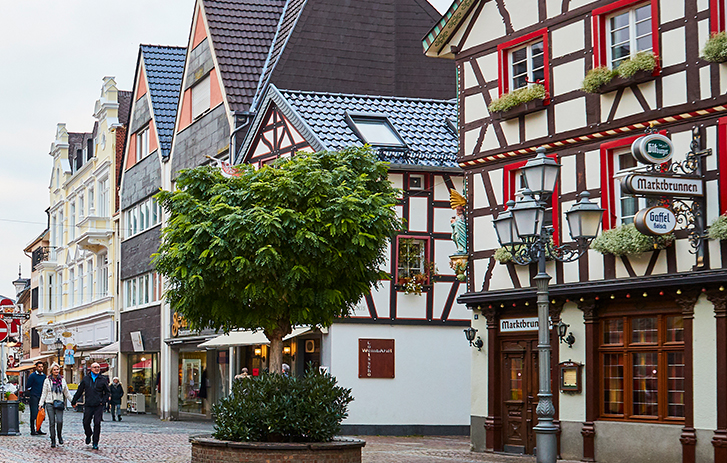
TRENDS & INSIGHTS / MARKET INTELLIGENCE
Executive summary
Germany has many favourable market attributes, including the largest economy in Europe, wealthy consumers, and significant scale in both imports and exports.
The country’s SMB sector – also known as Mittelstand – is highly innovative and could offer valuable opportunities for joint ventures, local supply chain optimisation, and easier market entry for European SMBs.
Germany’s consumers are known for their preference for high quality products, while sustainability and trust are also important.
E-commerce is an important market in Germany Marketplaces are dominant, social commerce is strong, and meeting consumer demands on delivery is key, so adapting platform, payment and shipping strategies to meet consumer expectations is essential for SMBs.
Germany: an economic powerhouse
Germany is one of the most important economies in the world, and as such it commands attention as both an export and import market for businesses throughout Europe.
Its economy is Europe’s biggest and the third largest in the world, second only to the U.S. and China.1 Consumers are wealthy, with high levels of disposable income – an average of $38,971 per capita per year, according to the OECD, the sixth largest of all OECD countries.2
And as well as being a big consumer economy, Germany is also the world’s third-largest exporting nation.3 Figures from the UN show that the country’s exports totalled $1.69 trillion in 20244, and what is particularly interesting is the scale of its SMB sector and the powerful role that it plays. Almost 97% of German exporters are SMBs,5 indicating a strong openness to overseas trade and collaboration within the sector.
The size of the economy, the strength of its industries and the purchasing power of its citizens mean it’s no surprise that Germany is also a key export market for many European countries. In fact, it is the largest export market for 15 EU countries, and among the top four export markets by value for all but two EU members.6
And trade is flowing both ways. Germany is also the largest source of imports for 14 EU member states, and in the top four import partners for all member states except Cyprus.7
All of this means that the country offers an array of potential opportunities for European businesses – as shown by Germany also being the top investment location in Europe.8
Germany… at a glance
€4.3
trillion
Germany’s GDP (2024)9
84.7
million
Population size10
95%
Percentage of population that are internet users11
€80.6
billion
Total online spending in Germany in 202412
German consumers: need to know
To succeed in Germany, it’s essential for SMBs to understand the underlying drivers ofconsumer choice. Key insights include:
Product quality is important: German consumers are known for valuing quality and durability in the products they buy, so this could be a key area for SMBs to focus on – for example by highlighting materials, certifications or warranties. Some are willing to pay more for a better product, and around 60% of consumers will stay loyal to a brand if theproducts are of high quality.13
Sustainability is a key concern: To a certain extent, sustainability is engrained in German consumers and it’s worth considering how your products and comms can align to this. Over 80% of consumers say they have an environmentally friendly lifestyle, for example, and this mindset translates to the products they buy with almost half thinking that extending product lifestyles should be a company priority.14 More importantly, 59% of consumers take sustainability into account when making purchase decisions – although that figure is slightly below the European average of 66%.15
Digital drives purchases: Internet penetration is high in Germany:
- Smartphone penetration rate crossed 90% in 2023.16
- Over 80% of the population is on social media, and digital advertising is expected to grow by 10% in 202517
- Over half of consumers research products online before making a major purchase18
These figures make it clear that digital-first strategies are an essential area to consider. Investing in SEO, localised content, and mobile-first experiences could help SMBs reach German consumers more effectively.
Trust is vital: Germans place a high value on trust. In fact, one survey suggests that 40% need to trust a brand before they buy.19 So focusing on ways to build confidence could be key to breaking through in the market. Prioritising customer service, encouraging reviews, ensuring transparent returns and having a strong and authentic brand identity are all good strategies to develop trust with consumers.
Three more strategic moves for SMBs entering Germany
Get to grips with Germany’s SMB sector
Germany’s manufacturing industry is a key driver of its economy, and at the heart of it is its SMB sector. Also known as Mittelstand, these businesses account for over 99% of all companies in Germany and employ more than half of all employees.20 They are also known for being highly innovative – around a third of all innovation and R&D spending in Germany comes from SMBs.21
What this means for businesses outside Germany is that the SMB sector could offer a key source of high-quality B2B products, which may potentially aid competitiveness in the international marketplace.
It could also become an important ally for those businesses trying to crack the German market themselves – either as an export destination or in potential partnerships with German businesses. This could open-up a range of benefits, from access to advanced technology and manufacturing capabilities to sustainability learnings and potential opportunities to tap into a skilled workforce.22
Dig deeper into e-commerce
Germany’s e-commerce sector is a big one. The second largest in Europe and sixth largest globally, online retail accounts for 17% of the country’s total retail market, with that figure expected to grow to 21% by 2028.23 So, it’s a market worth giving careful consideration to. And that includes understanding how people buy.
Marketplaces are dominant. Their share of revenue now stands at 55%, with success coming through a winning combination of convenience, variety and competitive prices.24
They also offer smaller businesses an easier way into the market, helping to make it more accessible for overseas sellers.
Marketplaces are not the only game in town though. Social commerce is also powerful, with almost 65% of 14-29-year-olds (and 20% of those aged 60 and over) having made a purchase based on social media content.25
And once a purchase has been made, delivery options are key and German consumers have some clear preferences that it’s worth SMBs being aware of:26
- Free shipping (important for 67% of people)
- Tracking (important for 63% of people)
- Free returns (important for 61% of people)
- Two-thirds (67%) of German consumers say free shipping is an important criteria, while 63% say tracking and 61% say free returns.26 In addition, a third of people say Environmentally friendly packaging (important for 34% of people)
- Carbon-neutral shipping (important for 23% of people).
Working with a provider that can deliver all these options could be another route to success.
Think local
Like most markets, Germany has some local quirks that it’s important to be aware of – and potentially cater for – if you are going to maximise success there. One of these is in online payments.
Digital wallets are the most popular payment method, but a sizeable number of online purchases are made through payment on invoice (40% of consumers use it as a payment method, according to one survey).27 This is when goods are shipped with an invoice (or one is emailed shortly after), and the customer then sends the payment on receipt of the item. This may not be common in other markets you trade in but offering it could be an important strategic call if targeting German consumers.
Growing your business in Germany and beyond
If you’re interested in exploring the German market further, this article contains a wide range of information to help you get the ball rolling and further your research. A good place to start is by contacting Germany Trade & Invest, which offers support to companies wishing to expand to Germany. But it might also be worth considering other markets in Europe too. Shipments within the EU are free of tariffs and border controls – a valuable commodity if current global trade tensions are causing any anxieties in other markets. You can learn more about some key Eastern European markets here, and you can also read our Spotlight on e-commerce in Europe to find out more about this crucial sector.
Disclaimer: The information provided on this page does not constitute legal, tax, finance, accounting, or trade advice, but is designed to provide general information relating to business and commerce. The FedEx Small Business Hub content, information, and services are not a substitute for obtaining the advice of a competent professional, for example (but not limited to) a licensed attorney, law firm, accountant, or financial adviser.
1 Economic Key Facts Germany | KPMG, 2025
2 OECD Better Life Index, Germany | OECD
3 Economic Key Facts Germany | KPMG, 2025
4 Germany Exports By Category | Trading Economics, 2025
5 The heart of the German economy | Deutschland.de, 2025
6 International trade in goods by partner | Eurostat, 2024
7 International trade in goods by partner | Eurostat, 2024
8 The German Market - Europe’s Economic Hub | Germany Trade & Invest
9 Gross domestic product in the 4th quarter of 2024 down 0.2% on the previous quarter | Destatis, 2025
10 Population by nationality and sex (quarterly figures) | Destatis, 2024
11 Ecommerce in Germany | Ecommerce News, 2025
12 German ecommerce is growing again | Ecommerce News, 2025
13 Germany: Reaching the consumer | Santander, 2025
14 German Attitudes towards Everyday Sustainability Consumer Report 2024 | Mintel, 2024
15 German sustainability-minded consumers look to second-hand and organic products | Consultancy.eu, 2025
16 Germany Financial Technology "FinTech" | International Trade Administration, 2023
17 Germany’s 2025 digital marketing landscape: Key trends | E-commerce Germany News
18 Attitudes towards online shopping in Germany as of December 2024 | Statista, 2025
19 Brand Trust in the Age of Information Overload | Intuit Mailchimp, 2024
20 The German Market - Europe’s Economic Hub | Germany Trade & Invest
21 The heart of the German economy | Deutschland.de, 2025
22 Partnership Opportunities In the German Manufacturing Industry, For Cross-Border UK Companies | Clear Border, 2025
23 The 5 Largest eCommerce Markets in Europe and What Makes Them Special | ECDB, 2024
24 Germany 2025: Marketplaces as the Driving Force Behind Growth | E-Commerce Institute Cologne, 2025
25 Germany 2025: Marketplaces as the Driving Force Behind Growth | E-Commerce Institute Cologne, 2025
26 Most important criteria for e-commerce delivery according to online shoppers in Germany | Statista, 2025
27 Ecommerce in Germany: everything you need to know | Mollie, 2024

